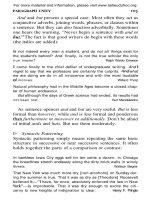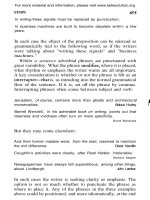Essential guide to writing part 8
Bạn đang xem bản rút gọn của tài liệu. Xem và tải ngay bản đầy đủ của tài liệu tại đây (286.78 KB, 15 trang )
PARAGRAPH UNITY
And and but present a special case. Most often they act as
conjunctive adverbs, joining words, phrases, or clauses within
a sentence. But they can also function adverbially. Sometimes
one hears the warning, "Never begin a sentence with and or
The fact is that good writers do begin with these words
(the italics are added):
not indeed every man a student, and do not all things exist for
the student's behoof? And, finally, is not the true scholar the only
true master? Ralph Waldo Emerson
come finally to the chief defiler of undergraduate writing. And
regret to say that we professors are certainly the culprits. what
we are doing we do in all innocence and with the most laudable
motives. Willard Thorp
Natural philosophy had in the Middle Ages become a closed chap-
ter of human endeavour. . . .
But although the days of Greek science had ended, its results had
not been lost. Kurt Mendelssohn
As sentence openers and and but are very useful. But is less
formal than however, while and is less formal and ponderous
furthermore or moreover or additionally. Don't be afraid
of initial ands and huts. But use them moderately.
l> Syntactic Patterning
Syntactic patterning simply means repeating the same basic
structure in successive or near successive sentences. It often
holds together the parts of a comparison or contrast:
In bankless Iowa City eggs sell for ten cents a dozen. In Chicago
the breadlines stretch endlessly along the dirty brick walls in windy
Streets. Wallace Stegner
That New York was much more dry [non-alcoholic] on Sunday dur-
ing the summer is true. That it was as dry as [Theodore] Roosevelt
believed have, for once, absolutely enforced the law in New
improbable. That it was dry enough to excite the citi-
zenry to new heights of indignation is clear. Henry F. Pringle
For more material and information, please visit www.tailieuduhoc.org
THE EXPOSITORY PARAGRAPH
Syntactic patterning may be more extensive, working
throughout most of a paragraph:
It is common knowledge that millions of underprivileged families
want adequate food and housing. What is less commonly remarked
is that after they have adequate food and housing they want to
be served at a fine restaurant and to have a weekend cottage by
the sea. People want tickets to the Philharmonic and vacation trips
abroad. They want fine china and silver dinner sets and handsome
clothes. The illiterate want to learn how to read. Then they want
education, and then more education, and then they want their sons
and daughters to become doctors and lawyers. It is frightening to
see so many millions of people wanting so much. It is almost like
being present at the Oklahoma land rush, except that millions are
involved instead of hundreds, and instead of land, the prize is
everything that life has to offer. Samuel c. Florman
While reusing the same sentence pattern often involves re-
peating some words, the similar grammatical structure is in
itself a strong connective device. However, you cannot im-
pose such syntactic patterning on just any group of sentences.
It works only when the underlying thought is repetitious, as
in the example above, where the sentences list a series of rising
expectations common to Americans. In such cases the simi-
larity of pattern does what ideally all sentence structure
should do: the form reinforces the sense.
For Practice
List all the transitional devices that link the sentences in the
following paragraph:
Above the beginner's level, the important fact is that writing cannot
be taught exclusively in a course called English Composition. Writ-
ing can only be taught by the united efforts of the entire teaching
staff. This holds good of any school, college, or university. Joint
effort is needed, not merely to "enforce the rules"; it is needed to
insure accuracy in every subject. How can an answer in physics or
a translation from the French or an historical statement be called
For more material and information, please visit www.tailieuduhoc.org
PARAGRAPH UNITY
correct if the phrasing is loose or the key word wrong? Students
argue that the reader of the paper knows perfectly well what is
meant. Probably so, but a written exercise is designed to be read;
it is not supposed to be a challenge to clairvoyance. My Italian-
born tailor periodically sends me a postcard which runs: "Your
clothes is ready and should come down for a fitting." understand
him, but the art honor him for is cutting cloth, not precision of
utterance. Now a student in college must be inspired to achieve in
all subjects the utmost accuracy of perception combined with the
utmost artistry of expression. The two merge and develop the sense
of good workmanship, or preference for quality and truth, which is
the chief mark of the genuinely educated man. Jacques Barzun
> The paragraph below lacks unity. The problem may be inade-
quate links between sentences, or it may go deeper, involving in-
coherence of thought. Rewrite the paragraph, staying as close as
possible to the original wording but changing what needs to be
changed to give the paragraph coherence and flow:
There are several kinds of test. Quizzes deal with only a small
amount of material, usually that covered in the preceding week or
two. Pop quizzes are often given without any announcement. Stu-
dents often miss them and have to arrange makeups. Examinations
are longer and cover more ground. The midterm comes in about
the sixth or seventh week and in some courses is the only grade
the teacher has for the midsemester mark. It is important. The final
comes at the end of the course and is a large part of your grade.
Students work hard preparing for finals.
For more material and information, please visit www.tailieuduhoc.org
CHAPTER
14
Paragraph Development:
(1) Illustration and Restatement
In this and the following several chapters we study how ex-
pository paragraphs develop. We focus on one technique of
development at a time, beginning with the simplest ones, il-
lustration and restatement. Of course, writers often combine
techniques. But walking comes before running, and for the
moment we concentrate on relatively uncomplicated
paragraphs.
Methods of paragraph development fall into three loose
groups: (1) those that stay strictly within the topic, offering
examples of it or merely repeating it in the varying ways; (2)
techniques involving another secondary or
of equal for comparison or contrast
or analogy; and (3) techniques that explore the ramifications
of the topic more it or looking into its causes
or effects.
Illustration
Citing examples is an easy way to support a generalization:
Some of those writers who most admired
Henry Adams, and H. G. Wells, for feared it
greatly. Samuel C.
For more material and information, please visit www.tailieuduhoc.org
(1) ILLUSTRATION AND RESTATEMENT
But an effect can become a cause, reinforcing the original cause
and producing the same effect in an intensified form, and so in-
definitely. A man may take to drink because he feels himself a
failure, and then fail all the more completely because he drinks.
George Orwell
Illustrations show that you are not talking through your
hat. Thus Florman gives us names, grounding his assertion in
facts and enabling us to check that assertion against our own
knowledge. Illustrations have a second virtue: they anchor an
abstraction in particulars, translating difficult ideas into
everyday terms. This is what Orwell does.
Brief examples like those by Florman and Orwell do not
make paragraphs, of course. But examples can be extended to
provide the substance of an entire paragraph. Sometimes the
paragraph consists of a single example worked out in detail:
Some of the most abstract terms in the language are really faded
metaphors. On examination it turns out that an earlier meaning,
now forgotten, is often lively in the extreme. Hence an obvious
means of invigorating our jejune vocabulary is to fall back on those
lively older meanings. True enough, the average speaker does not
know that they ever existed. He is not reminded that "express"
once meant, literally and physically, "to press out." But he can
learn it instantaneously from a context. It may be that only the
archaic literal sense is intended, or it may be that both the physical
and the metaphorical are to be grasped simultaneously. In any
event, the impact of the divergent use on an attentive reader forces
him to a new experience of the word, without sacrificing compre-
hension. An example of the use of "express" in this revivified fash-
ion will be found in Emily Dickinson:
Essential
The Attar from the Rose
Be not expressed by
is the gift Margaret Schlauch
On the other hand a paragraph may consist of a number of
brief examples, as in this passage about the change in modern
modes of eating and drinking:
For more material and information, please visit www.tailieuduhoc.org
THE EXPOSITORY PARAGRAPH
As far as the home is concerned, the biggest change in what P. C.
Wodehouse called "browsing and sluicing" is probably not the de-
cline in huge, formal meals, or shorter menus, but the odd form our
food is in nowadays when we buy it. Coffee comes as a powder.
Fish arrives as a frozen rectangular block. Soup, stiff with preser-
vatives, comes in a tin or as a powder. Potatoes no longer wear
their jackets but arrive pale and naked in an impenetrable plastic
bag. Embryonic mashed potato comes in little dry lumps, like cattle-
feed pellets. Bread, untouched by human baker, arrives wrapped
and sliced in a soft lump, the "crust" seemingly sprayed on. Beer,
urged upward by gas, emerges from a steel dustbin. Frank
Whether you use one example or several, be sure your
reader will take them for what they are. Often it is advisable
explicitly to introduce an illustration by some such phrase as
for example, for instance, as a case in point or, a bit more
subtly, say, thus, consider. Vary these expressions; do not in-
troduce every illustration with for example. Nor is it neces-
sary always to place the phrase in the opening position. for
instance for example is equally effective set between subject
and verb, where it is still near the beginning but seems less
mechanical.
When the illustrative function of a detail is obvious, you
can safely dispense with an introductory phrase. Orwell does
not write, "For example, a man may take to drink ..."; nor
does Muir label his instances of the oddity of modern food.
They depend on the reader's common sense. No infallible rule
tells you when for example is superfluous and when its ab-
sence will confuse a reader. You must try to imagine yourself
in the reader's place. If an illustration seems even a bit be-
wildering without an introductory word or phrase, put one
in.
Introduced or not, examples are most effective when they
are specific. In Muir's paragraph the abstract expression
odd form our food is in" is given heft and shape by "frozen
rectangular block," "pale and naked in an impenetrable plas-
tic bag," "little dry lumps, like cattle-feed pellets."
For more material and information, please visit www.tailieuduhoc.org









